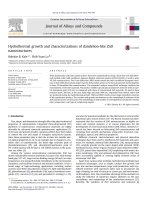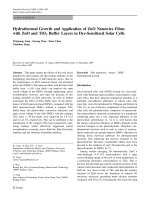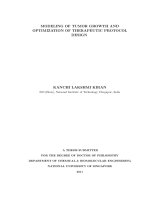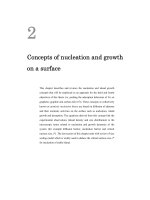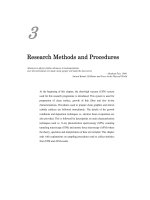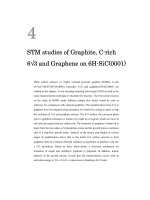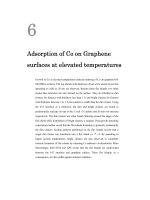hydrothermal growth and characterizations of dandelion-like zno
Bạn đang xem bản rút gọn của tài liệu. Xem và tải ngay bản đầy đủ của tài liệu tại đây (2.1 MB, 6 trang )
Hydrothermal growth and characterizations of dandelion-like ZnO
nanostructures
Rohidas B. Kale
a,
⇑
, Shih-Yuan Lu
b,
⇑
a
Department of Physics, The Institute of Science, Madam Cama Road, Mumbai 400 032, (M.S.), India
b
Department of Chemical Engineering, National Tsing-Hua University, Hsinchu 30013, Taiwan, ROC
article info
Article history:
Received 16 April 2013
Received in revised form 13 May 2013
Accepted 16 May 2013
Available online 19 June 2013
Keywords:
Chemical synthesis
X-ray diffraction
Scanning electron microscopy
Luminescence
abstract
Three dimensional (3D) ZnO nanostructures have been synthesized by using a facile low-cost hydrother-
mal method under mild conditions. Aqueous alkaline ammonia solution of Zn(CH
3
COO)
2
is used to grow
3D ZnO nanostructures. The X-ray diffraction (XRD) study reveals the well crystallized hexagonal struc-
ture of ZnO. SEM observations depict that the ZnO product grows in the form of nanorods united together
to form 3D dandelion-like nanostructures. The elemental analysis using EDAX technique confirms the
stoichiometry of the ZnO nanorods. The product exhibits special optical properties with red-shifts in opti-
cal absorption peak (376 nm) as compared with those of conventional ZnO nanorods. PL spectra show
emission peak (396 nm) at the near band-edge and peak (464 nm) originated from defects states that
are produced during the hydrothermal growth. TEM and SAED results reveal single crystalline structure
of the synthesized product. The reaction and growth mechanisms on the morphological evolution of the
ZnO nanostructures are discussed. The morphology of ZnO product is investigated by varying the reaction
time, temperature, and type of complexing reagent.
Ó 2013 Elsevier B.V. All rights reserved.
1. Introduction
Size, shape, and dimensions strongly affect the physicochemical
properties of nanomaterials. Integrated three-dimensional (3D)
platforms of nanostructure semiconductor materials are highly
desirable for advanced nanoscale optoelectronic applications [1].
In the past and present decades, numerous efforts have been taken
to control the size and shape of inorganic nano/micro-crystals.
Since these parameters play a vital role in their size tunable elec-
tro-optical properties [2–4]. As an example, due to changes in crys-
tallite sizes of nanomaterials, the band edge emission peak of
photoluminescence (PL) and absorption/transmission peak of
UV–visible spectra will be blue or red shifted, known as the quan-
tum size effect [5].
Among the various semiconductor nanomaterials, ZnO has
drawn considerable research attentions, because of its wide energy
band gap (3.37 eV), large exciton binding energy (60 meV) at room
temperature, low lasing threshold, friendliness to the environment,
cheapness, and excellent chemical and thermal stabilities. It has a
broad range of high-technology applications, including surface
acoustic wave filters [6], photonic crystals [7], light emitting diodes
[8], photodetectors [9], photodiodes [10], optical modulator wave-
guides [11], varistors [12], gas and piezoelectric sensing [13–15],
and also the potential candidate for the fabrication of several other
functional nano-/micro devices [16–19]. Recent research has dem-
onstrated that the creation of ZnO nanostructures in highly ori-
ented and ordered manners is of crucial importance for the
development of novel functional devices [20]. Hence, intensive re-
search has been focused on fabricating ZnO nanostructures and
revealing their growth mechanisms along-with structural, mor-
phological, optical, and electrical properties.
Different chemical, electrochemical, and physical deposition
techniques have been used to synthesize ZnO nanorods and nano-
wires. For example, chemical bath deposition [18], spray pyrolysis
[21], catalytic growth via the vapor–liquid–solid epitaxial (VLSE)
mechanisms [22], metal–organic chemical vapor deposition (MOC-
VD) [23], pulsed laser deposition [24], templating with anodic alu-
mina membranes [25], and epitaxial electrodeposition [26] have
been successfully applied in creating highly oriented arrays of
anisotropic ZnO NRs.
Apart from various other methods, hydrothermal methods have
numerous advantages, such as simple, catalyst free growth, low
cost, low reaction temperatures, large scale production, well crys-
tallized materials with maximum yield, easy to incorporate any
type of doping, no need of vacuum or carrier gas, and environmen-
tal friendliness. Also, the remarkable advantage of this method is to
study the influence of numerous organic additives on the size,
crystallinity, and morphology of the synthesized products [27].
Recently, the synthesis of ZnO nanowires and nanorods by
0925-8388/$ - see front matter Ó 2013 Elsevier B.V. All rights reserved.
/>⇑
Corresponding authors. Tel.: +886 3 571464; fax: +886 3 5715408.
E-mail addresses: (R.B. Kale), (S Y. Lu).
Journal of Alloys and Compounds 579 (2013) 444–449
Contents lists available at SciVerse ScienceDirect
Journal of Alloys and Compounds
journal homepage: www.elsevier.com/locate/jalcom
solvothermal processes has been reported [28–30]. However, it is
inevitable to use toxic, dangerous, and expensive solvents such
as amine and methanol in the solvothermal process.
In this communication, we report on the controlled synthesis of
dandelion-like ZnO morphologies with nanorods united together
to form 3D nanostructures by using a simple hydrothermal route.
Moreover, our product shows enhanced ultraviolet emissions at
room temperature, which may inspire researchers and technolo-
gists to fabricate convenient nano/micro-devices of ZnO materials
with novel unique optical properties.
2. Experimental section
2.1. Experimental procedure
All the reagents used in the experiments are in analytical grade (purchased from
Shaowa Chem. Co. Ltd., Japan) and used without further purification. To prepare the
present dandelion-like ZnO nanostructures, 0.05 M of zinc acetate dihydrate
[Zn(CH
3
COO)
2
.2H
2
O] is dissolved in 120 mL of deionized water ((Milliq 18.2 M
X
).
An appropriate amount of ammonium hydroxide NH
4
OH (0.5 M) is dripped under
constant stirring. The mixture is enclosed into a Teflon-lined stainless steel auto-
clave. The autoclave is kept in an oven maintained at 180 °C for 24 h. White prod-
ucts are collected from the bottom of the autoclave and repeatedly washed with
distilled water and absolute ethanol. Finally, the product is dried in air at 80–
100 °C for 6 h and used for further characterizations.
2.2. Characterization
The crystallographic structure of the resulting ZnO product is analyzed using an
X-ray diffractometer (XRD, Mac Science, MXP18) with Cu K
a
(k = 1.5406 Å) radia-
tion in the 2h range from 20 to 80°. The morphology is studied using a scanning
electron microscope (SEM) (JEOL, JSM-5600) equipped with an energy dispersive
X-ray analyzer (EDAX, Oxford Instruments) to detect the elemental proportion. A
small amount of collected product is dispersed in ethanol, and small drops of the
sample are deposited on a carbon grid. The sample is coated with a thin gold
(Au) layer using an SEM sputter (SPI-Module Sputter Coating Unit, USA). The ob-
tained ZnO product is further characterized with a transmission electron micro-
scope (TEM) and selected area electron diffraction (SAED), using JEOL JEM-2010.
To study the optical properties, optical absorption spectra are recorded in the wave-
length range of 325–800 nm, using a UV–visible spectrometer (Hitachi Model-3300,
Japan). Photoluminescence (PL) study is carried out using a Hitachi F-4500 model
equipped with a xenon lamp as the light source. The room-temperature photo lumi-
nescence (PL) spectra were measured using 330 nm as an excitation wavelength. An
appropriate amount of ZnO powder is well dispersed in ethanol to study optical
properties.
3. Results and discussion
3.1. Crystal structure
The most stable crystalline structure of ZnO is the hexagonal
(wurtzite) phase that occurs in nature as mineral zincite. Its ionic
and polar structure can be described with hexagonal close packing
(HCP) of oxygen and zinc atoms in space group of P63mc with zinc
atoms occupying the tetrahedral sites (point group 3m). The occu-
pancy of four of the eight tetrahedral sites of the HCP array controls
the crystal structure. The unit cell contains two formula units and
the typical crystal growth habit exhibits two types of low-index
surfaces: (i) polar surfaces (000–1) (O-terminated surface) and
(0001) (Zn-terminated surface) and (ii) non-polar (01–10), (10–
10), etc. surfaces; and C
6v
-symmetric ones parallel to the c-axis.
Also, there is no centre of inversion in the wurtzite structure and
therefore an inherent asymmetry is present which allows aniso-
tropic growth along the c-axis [31].
The balance between the kinetic and thermodynamic controls
during the crystal growth determines the final growth habit of a
formed crystal. Thermodynamically, crystal growth occurring in
aqueous solutions mainly depends on the characteristics of me-
tal-legend complexes, their solubility’s and ionic products along
with crystal surface energies. From the kinetically controlled reac-
tion process, the growth habit of a crystal mainly depends on the
relative growth rate of its various crystal faces. Hence, kinetically
controlled crystal growth may be different from the thermody-
namically predicted crystal growth habit. ZnO is an interesting
candidate to study the growth habit of crystal under hydrothermal
conditions. It has been proposed that when the growth rate is slow
(thermodynamic control), crystals tend to grow as low aspect ratio
polyhedral. If kinetically controlled, i.e. at higher growth rates, the
commonly observed morphologies are elongated crystals along the
c-axis and with hexagonal prismatic faces [33–35]. Growth mech-
anisms and the proposed models were developed and depend on
the experimentally observed crystal growth habits. The periodic
bond chain (PBC) theory [35] is an important model to predict
the thermodynamically stable growth habit of a crystal. However,
in general, this model fails to explain the usually observed mor-
phologies of polar crystals, such as ZnO, for crystal growth under
kinetic control and hydrothermal conditions. For this reason, other
models such as the coordination polyhedron growth (CPG) model
have been postulated. According to this model, the relative rates
of the ZnO crystal growth in different directions are reported to
be V(0001) > V(0
1
1
1) > V(0 1
10) > V(000
1) that gives the aniso-
tropic one-dimensional growth of ZnO crystals [31 and references
therein].
3.2. Structural study
Fig. 1 shows the X-ray diffraction (XRD) pattern of as-synthe-
sized ZnO products. The diffraction peaks positioned at different
2h values 31.6, 34.26, 36, 47.34, 56.42, 62.74, 66.18, 67.74,
68.88, 72.42, 76.56 and their relative intensities compared with
standard intensities can be indexed to pure hexagonal wurtzite
phase of zinc oxide (JCPDS No 05-0664). The well resolved sharp
XRD peaks with narrow FWHM of the diffraction pattern indicate
that the product is well crystallized with excellent crystalline
quality and there is no need for further thermal treatments. The
peaks corresponding to possible impurity phases are not detected
in the XRD pattern, confirming the high purity of the ZnO product.
The calculated average lattice constants are a = 3.263 Å and
c = 5.230 Å that are in good agreement with the standard values
(JCPDS #05-0664).
Fig. 1. XRD pattern of the dandelion-like ZnO nanostructures.
R.B. Kale, S Y. Lu / Journal of Alloys and Compounds 579 (2013) 444–449
445
3.3. Compositional study
In order to determine the elemental stoichiometric ratio, EDAX
is taken at different locations of the samples. Fig. 2 shows a typical
EDAX pattern of the ZnO product. The elemental analysis is carried
out only for Zn and O elements. The average atomic percentage of
Zn:O was 49:51, that confirms the stoichiometric ratio (1:1) of the
ZnO product. The peaks marked as ‘‘1’’ and ‘‘2’’ are contributed by
the carbon coated grid and Au sputtering, respectively.
3.4. Morphological study
The morphology of semiconductor nanomaterials needs to be
optimized for specific applications. The morphology has been
shown to affect catalytic and photocatalytic activities and influ-
ence the structural and optoelectronic properties [31–33]. Hence,
the morphology of the product is further examined by a scanning
electron microscope. Fig. 3a and b shows the SEM images of the
as-synthesized product with different magnifications. SEM images
clearly reveal that the product consists of closely packed nanorods
that are united together to form dandelion-like 3D nanostructures.
Additional morphological characterizations of the ZnO nano-
structure are carried out using a transmission electron microscope.
Fig. 4a and b shows TEM images of a 3D ZnO nanostructure and an
individual nanorod. TEM pictures reveal that the one end of the
nanorod is wider ($100 nm) with gradual decrease in diameter
along its length and finally emerges to form a sharp tip. The SAED
pattern is as shown in Fig. 5a, reveals the single-crystallinity of the
ZnO nanorod. Fig. 5b shows a high-resolution TEM (HRTEM) image
of an individual sword-like ZnO nanorod. The image clearly reveals
the fringes of the ZnO with a lattice spacing of $0.259 nm, indicat-
ing that the ZnO nanorod is single crystalline in nature, consistent
with the conclusion of the SAED pattern. Furthermore, the inter-
layer distance of 0.259 nm corresponds well with the lattice spac-
ing of the (0 0 2) crystal planes of ZnO, suggesting growth of the
ZnO nanorods in the (0 0 1) direction.
A wide variety of ZnO nanorods [21,34–37] is observed in both
powder and thin film form, but the diameters of the reported nano-
rods are nearly constant throughout their lengths. The present
interesting morphology of the ZnO structure consists of long sword
shaped, bundled, closely packed nanorods that may offer unique
optical properties along with gas sensor applications.
For nanomaterials, not only length and diameter but also the tip
shape impact their physical properties and performances in elec-
tronic devices. In the last decade, researchers are greatly attracted
towards the size effects of 1D nanostructure; however the shape
effects of the 1D nanomaterial remained relatively unexplored.
Furthermore, the anisotropic growth of the crystal contributes to
the formation of the nanorods. At the first step of the growth, the
initial ZnO crystal seeds nucleate randomly, without any preferred
orientation. Since the growth rate along the c-axis of ZnO is the
highest, the nuclei with this orientation will grow faster and tend
to dominate. Eventually, well-oriented nanorods unite at the initial
nucleating sites that form the dandelion-like nanostructure with
bundled nanorods.
3.5. Optical properties
ZnO exhibits a wide band gap at room temperature with a large
exciton binding energy, which makes it an intriguing candidate for
effective UV emissions. However, because of the often dominant
presence of structural defects, the UV emission of ZnO nanomate-
rials is liable to be quenched and only defect emissions in visible
region are detected [38,39]. This limits the progress and use of
ZnO in optoelectronic and lasing devices. Therefore, how to im-
prove the crystalline quality of ZnO by synthetic processing and
how to realize UV emissions and lasing are still major challenges.
The 3D ZnO nanostructure obtained in the typical synthesis pro-
cess is 3D nanostructure consisting of bundles of nanorods grown
with sharp tips. This suggests possible interesting optical and
electrical properties of this novel 3D structure. Also, the optical
measurements, such as optical absorption/transmission and pho-
toluminescence, are very useful for the determination of the struc-
ture, defects, and impurities present in these nanostructures. Fig. 6
illustrates the UV–visible absorption and transmission spectra of
the 3D ZnO nanostructure. It shows a strong and sharp excitonic
absorption (maximum)/transmission (minimum) peak centered
at 376 nm, which is slightly red-shifted as compared with that of
the bulk ZnO (Eg
bulk
= 3.35 eV, k
max
$ 370 nm). Generally, an exci-
tonic absorption/transmission peak appears if the defect density
Fig. 2. EDAX pattern of the dandelion-like ZnO nanostructures.
Fig. 3. SEM images of dandelion-like ZnO nanostructures (a) 10 kX and (b) 15 kX.
446 R.B. Kale, S Y. Lu / Journal of Alloys and Compounds 579 (2013) 444–449
is considerably low. Therefore, from the optical absorption/ trans-
mission spectrum, it is evident that the ZnO nanostructures so
formed are of high optical quality. To confirm the optical behavior,
the room temperature PL spectrum has been recorded and is
shown in Fig. 7. The sample exhibits strong UV emissions at
396 nm, followed by much weaker blue-emissions centered at
464 nm. The near UV emission of the ZnO originates from the
Fig. 4. TEM of (a) dandelion-like ZnO nanostructure and (b) an individual ZnO nanorod.
Fig. 5. (a) SAED pattern of ZnO nanorod and (b) HRTEM image of a ZnO nanorod.
Fig. 6. UV–visible absorption spectrum of the dandelion-like ZnO nanostructures.
Inset shows the corresponding transmission spectrum.
Fig. 7. Room-temperature photoluminescence spectrum of dandelion-like ZnO
nanostructures.
R.B. Kale, S Y. Lu / Journal of Alloys and Compounds 579 (2013) 444–449
447
recombination of free excitons [40]. The weak blue emission peak
centered at 464 nm may be attributed to surface deep traps emis-
sion of ZnO nanorods could originated from transitions involving
Zn interstitial defect states [41]. It is worth mentioning, as com-
pared with common ZnO nanorods and nanowires [40,41], the
UV absorption/transmission and PL emission peaks of the present
product exhibit red-shifts from the corresponding bulk values. Pre-
vious research has shown that the PL spectrum of ZnO is sensitive
to the product shape, product size, temperature, preparation meth-
od [42], etc. Therefore, these particular UV emission behaviors may
be related to the special 3D dandelion-like ZnO nanostructure
assembled by uniform nanorods with narrow tips. Such a type of
red-shift was also reported by Ge et al. [43] for 3D ZnO nanostruc-
ture. In the present case, a strong and dominant UV emission with
a weak blue emission has been observed which confirms that the
synthesized ZnO nanostructures have good optical properties with
very few zinc interstitials defects.
3.6. Reaction and growth mechanisms of 3D ZnO nanostructures
According to previous researchers [37] and our own experimen-
tal evidences, the growth process of ZnO nanostructures generally
takes place via the following reaction mechanisms in the presence
of an excess amount of ammonium hydroxide:
ZnðCH
3
COOÞ
2
! Zn
2þ
þ 2ðCH
3
COOÞ
À
2
NH
3
þ H
2
O ! NH
þ
4
þ OH
À
Zn
2þ
þ 4NH
3
! ZnðNH
3
Þ
2þ
4
ZnðNH
3
Þ
2þ
4
þ 4OH
À
! ZnðOHÞ
2À
4
þ 4NH
3
ZnðOHÞ
2À
4
! ZnO þ H
2
O þ 2OH
À
The morphology of ZnO is very sensitive to the preparative param-
eters and ZnO is thus an intriguing candidate to study the growth
habit of hexagonal structure under different experimental condi-
tions. To understand the growth mechanism of the 3D ZnO nano-
structures, the ZnO product is also synthesized for a much shorter
reaction time of 6 h. Fig. 8 shows SEM images of the ZnO product
of this case. It clearly reveals the flowerlike morphology that con-
sists of small nanorods surrounded by some thin sheet structure.
Fig. 9 shows a typical EDAX pattern of the ZnO product, with the
inserted box showing the region selected for the analysis, and the
derived elemental composition. The analysis shows that the region
consists of compounds rich in oxygen, clearly confirming that the
surrounded thin sheet structure is of ZnðOHÞ
2À
4
and converts into
ZnO nanorods at prolonged times.
In the presence of an excess aqueous ammonia, the quantity of
Zn(OH)
2
is almost negligible and the abundant quantity of
ZnðNH
3
Þ
2þ
4
forms in the resultant precursor. The species of
ZnðNH
3
Þ
2À
4
can be readily decomposed to free Zn
2+
and form a large
quantity of active species of [Zn(OH)
4
]
2À
. Therefore, there are en-
ough growth units of [Zn(OH)
4
]
2À
to produce ZnO nanorods, that
grow from the circumference of the ZnO particles leading to forma-
tion of the dandelion-like ZnO nanostructure.
Keeping all the experimental conditions invariant but increas-
ing the reaction temperature up to 200 °C, the morphology
(Fig. 10) of the synthesized ZnO product shows an oriented attach-
ment growth of microrods that are considerably shortened in
length with enlarged diameter. The aspect ratio of the constituent
rods of this ZnO product is thus much decreased. Also the morphol-
ogy is observed (Fig. 11) for products prepared without disturbing
the experimental conditions described in the experimental section
but replacing the pH adjusting reagent NH
4
OH with NaOH. It re-
veals evident changes in morphology, showing the existence of
individual nanorods of diameter $200 nm and of elongated length
in the range of $3
l
m.
Fig. 8. SEM image of ZnO nanostructure synthesized with a reaction time of 6 h.
Fig. 9. EDAX pattern and its relevant compositional analysis.
Fig. 10. SEM image of ZnO product synthesized at an elevated temperature 200 °C.
448 R.B. Kale, S Y. Lu / Journal of Alloys and Compounds 579 (2013) 444–449
4. Conclusion
In summary, we have developed a facile hydrothermal method
for the preparation of dandelion-like ZnO nanostructures by using
aqueous ammonia solutions, at relatively low temperatures. The
XRD, UV–visible, and PL studies reveal that the as-prepared 3D
ZnO nanostructure possesses hexagonal crystalline structure with
a remarkable optical quality. The present synthetic route, free of
templates and surfactants, can be readily adjusted to prepare novel
flowerlike 3D ZnO nanostructure. The hydrothermal method might
be extended for the preparation of other oxide semiconductors.
The reaction and growth mechanisms clearly reveal that the active
species [Zn(OH)
4
]
2À
plays an inevitable role to grow the 3D dande-
lion-like morphology. The present morphology of ZnO offers new
insight to prepare other oxide nanomaterials of desired morphol-
ogy, which is useful for applications in optoelectronic devices.
We also conclude that the reaction time and temperature play an
important role that dramatically changes the morphology of the
synthesized ZnO product.
References
[1] A.P. Alivisatos, J. Phys. Chem. 100 (1996) 13226–13239.
[2] X. Duan, Y. Huang, R. Agarwal, C.M. Lieber, Nature 421 (2003) 241–245.
[3] B. Gates, B. Mayers, A. Grossman, Y. Xia, Adv. Mater. 141 (2002) 1749–1752.
[4] M. Huang, S. Mao, H. Feick, H. Yan, Y. Wu, H. Kind, E. Weber, R. Russo, P. Yang,
Science 292 (2001) 1897–1899
.
[5] R.B. Kale, C.D. Lokhande, J. Phys. Chem. B 109 (2005) 20288–20294.
[6] N.D. Emanetouglu, C. Gorla, Y. Liu, S. Liang, Y. Lu, Mater. Sci. Semicond. Process
2 (1999) 247–252
.
[7] Y. Chen, D. Bagnall, T. Yao, Mater. Sci. Eng. B 75 (2005) 190–198.
[8] G. Xiong, U. Pal, J.G. Serrano, J. Appl. Phys. 101 (2007) 24317-0–24317-6. 6.
[9] S. Liang, H. Sheng, Y. Liu, Z. Hio, Y. Lu, H. Shen, J. Cryst. Growth 225 (2001) 110–
113
.
[10] J.Y. Lee, Y.S. Choi, J.H. Kim, M.O. Park, S. Im, Thin Solid Film 403 (2002) 553–
557
.
[11] M.H. Koch, P.Y. Timbrell, R.N. Lamb, Semicond. Sci. Technol. 10 (1995) 1523–
1527
.
[12] Y. Lin, Z. Zhang, Z. Tang, F. Yuan, J. Li, Adv. Mater. Opt. Electron. 9 (1999) 205–
209
.
[13] N. Golego, S.A. Studenikin, M. Studenikin, M. Cocivera, J. Electrochem. Soc. 147
(2000) 1592–1594
.
[14] E. Comini, G. Fagila, G. Sberveglieri, Z. Pan, Z.L. Wang, Appl. Phys. Lett. 81
(2002) 1869–1871
.
[15] X.D. Bai, P.X. Gao, Z.L. Wang, E.G. Wang, Appl. Phys. Lett. 82 (2003) 4806–4808.
[16] J.J. Hassan, Z. Hassan, H-Abu Hassan, J. Alloys Comp. 23 (2011) 6711–6719.
[17] X. Li, Y. Wang, J. Alloys Comp. 19 (2011) 5765–5768.
[18] V.R. Shinde, C.D. Lokhande, R.S. Mane, S.H. Han, Appl. Surf. Sci. 245 (2005)
407–413
.
[19] N. Lepot, M.K. Van Bael, H. Van den Rul, J. D ‘Haen, R. Peeters, D. Franco, J.
Mullens, Mater. Lett. 61 (2007) 2624–2627
.
[20] Q. Li, V. Kumar, Y. Li, H. Zhang, T.J. Marks, R.P.H. Chang, Chem. Mater. 17 (2005)
1001–1006
.
[21] V.R. Shinde, T.P. Gujar, C.D. Lokhande, Sens. Actuators, B: Chem. 120 (2007)
551–559
.
[22] H. Huang, Y. Wu, H. Feick, N. Tran, E. Weber, P. Yang, Adv. Mater. 13 (2001)
113–116
.
[23] S. Liu, J. Wu, J. Mater. Res. Soc. Symp. Proc. 703 (2002) 241–242.
[24] J.H. Choi, H. Tabata, T. Kawai, J. Cryst. Growth 226 (2001) 493–500.
[25] Y. Li, G.W. Meng, L.D. Zhang, F. Phillip, Appl. Phys. Lett. 76 (2000) 2011–2013.
[26] R. Liu, A.A. Vertegel, E.W. Bohannan, T.A. Sorenson, J.A. Switzer, Chem. Mater.
13 (2001) 508–512
.
[27] Y. Peng, A. Xu, M. Antonietti, H. Colfen, J. Phys. Chem. B 110 (2006) 2988–2993.
[28] J. Zhang, L.D. Sun, H.Y. Pan, C.S. Liao, C.H. Yan, New J. Chem. 26 (2002) 33–34.
[29] C. Pacholski, A. Kornowski, H. Weller, Angew. Chem., Int. Ed. 41 (2002) 1188–
1191
.
[30] U. Pal, P.J. Santiago, J. Phys. Chem. B 109 (2005) 15317–15321.
[31] A.M. Peiro, J.A. Ayllon, J. Peral, X. Domenech, C. Domingo, J. Cryst. Growth 285
(2005) 6–16
.
[32] D. Li, H. Haneda, Chemosphere 51 (2003) 129–137.
[33] D. Scarano, G. Spoto, S. Bordig, A. Zecchina, C. Lamberti, Surf. Sci. 276 (1992)
281–298
.
[34] L. Guo, Y. Ji, H. Xu, J. Am. Chem. Soc. 124 (2002) 14864–14865.
[35] B. Cheng, E. Samulski, Chem. Commun. 8 (2004) 986–987;
P. Hartman, W.G. Perdok, Acta Crystallogr. 8 (1955) 525–529.
[36] W.J. Li, E.W. Shi, W.Z. Zhong, Z.W. Yin, J. Cryst. Growth 203 (1999) 186–196.
[37] D.S. Boyle, K. Govender, P. O’Brien, Chem. Commun. 1 (2002) 80–81.
[38] J. Zhang, L. Sun, J. Yin, H. Su, C. Liao, C. Yan, Chem. Mater. 14 (2002) 4172–4177.
[39] Y.C. Kong, D.P. Yu, B. Zhang, W. Fang, S.Q. Feng, Appl. Phys. Lett. 78 (2001) 407–
409
.
[40] E.M. Wong, P.C. Searson, Appl. Phys. Lett. 74 (1999) 2939–2941;
S. Monticone, R. Tufen, A.V. Kanaev, J. Phys. Chem. B 102 (1998) 2854–2862’;
B.D. Yao, H.Z. Shi, H.J. Bi, L.D. Zhang, J. Phys.: Condens. Matter 12 (2000) 6265–
6270
;
S. Choi, E. Kim, J. Park, K. An, N. Lee, S.C. Kim, T. Hyeon, J. Phys. Chem. B 109
(2005) 14792
.
[41] K. Vanheusden, W.L. Warren, C.H. Seager, D.R. Tallant, J.A. Voigt, B.E. Gnade, J.
Appl. Phys. 79 (1996) 7983–7990
;
Y. Li, G.S. Cheng, L.D. Zhang, J. Mater. Res. 15 (2000) 2305–2308;
J.Q. Hu, Q. Li, N.B. Wong, C.S. Lee, S.T. Lee, Chem. Mater. 14 (2002) 1216–1219;
Y. Wu, W. Wu, X.M. Zou, L. Xu, J.C. Li, Mater. Lett. 86 (2012) 182–185;
H. Zeng, G. Duan, Y. Li, S. Yang, X. Xu, W. Cai, Adv. Funct. Mater. 20 (2010) 561–
572
.
[42] L. Guo, Y.L. Ji, H. Xu, P. Simon, Z. Wu, J. Am. Chem. Soc. 124 (2002) 14864–
14865
.
[43] J. Ge, B.L. Tang, S.Z. Zhuo, Z. Shi, Nanotechnology 5 (2006) 1316–1322.
Fig. 11. SEM image of ZnO synthesized using NaOH.
R.B. Kale, S Y. Lu / Journal of Alloys and Compounds 579 (2013) 444–449
449
